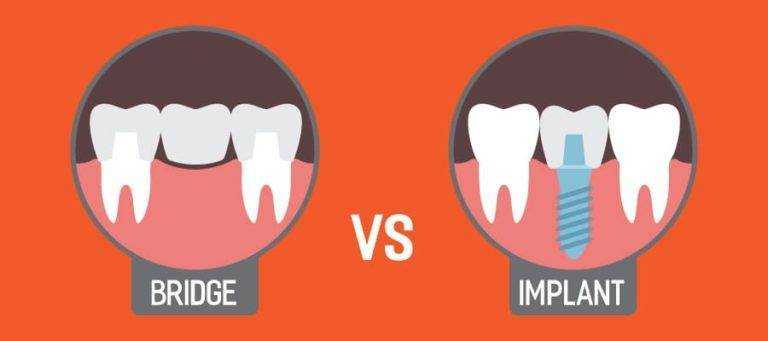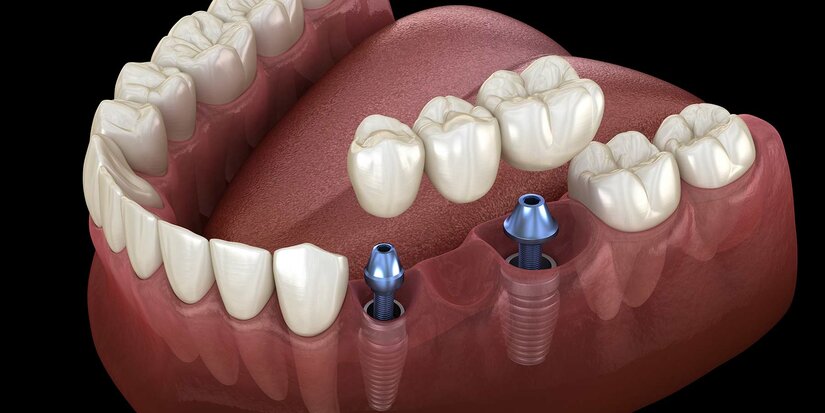Dental Implants Vs. Bridges: Which Is Right For You?

Are you considering dental implants or bridges? It can be difficult to decide which option is right for you. Dental implants and bridges are two common treatments for replacing missing teeth, but they have different advantages and disadvantages. This article will help break down the differences between dental implants and bridges, so you can make an informed decision about your next steps.
Are you looking to replace a missing tooth with something that looks and feels natural? You may want to consider dental implants. A dental implant is a titanium screw that’s surgically inserted into your jawbone. It acts as a replacement root for the missing tooth, providing an anchor point for the artificial crown that sits on top of it. Dental implants are strong, durable, and look like real teeth – making them a great choice if aesthetics are important to you.
A bridge is another option when it comes to replacing missing teeth. Bridges are made up of one or more artificial teeth that are held in place by crowns on either side of the gap created by the missing teeth. The bridge is attached to your existing healthy teeth (or implants) adjacent to the area where you’re missing teeth, creating a “bridge” of sorts over the gap in your mouth. Bridges are typically less expensive than implants and can be completed in fewer appointments – making them an attractive option if cost or convenience is a factor for you.
In this article, we’ll explore both options in greater detail so you can make an informed decision about which treatment is best for your needs. Read on to learn more about dental implants vs bridges!
Advantages Of Dental Implants And Bridges Compared
Are you considering the option of dental implants or bridges to improve your smile? Ah, the irony – in a way, it’s like trying to decide between two different types of dentistry! But fear not, for there are advantages and disadvantages to both.
Let’s start with dental implants. They are typically made from titanium and inserted directly into your jawbone. This makes them extremely durable and long-lasting; in some cases, they can last a lifetime if properly cared for. Additionally, since they are embedded in the jawbone, they don’t require any additional support structures (such as crowns) to remain stable.
Moving onto bridges: these are artificial teeth that connect to adjacent existing teeth using crowns. While this does provide a more natural look and feel than an implant, it requires more maintenance due to its reliance on the supporting teeth and surrounding tissues for stability. Additionally, bridges may need replacement over time if the underlying teeth decay or become damaged.
As you can see, both options have their own unique advantages and disadvantages that you’ll want to consider before making your decision. Ultimately, it will come down to your individual needs and circumstances that will determine which solution is right for you.
Disadvantages Of Dental Implants And Bridges Compared
When it comes to the disadvantages of dental implants and bridges, there are a few things to consider. Dental implants can be costly, and if you have multiple missing teeth, the cost can add up quickly. In addition, dental implants require surgery and an extended healing time of several months. This may be a disadvantage for people who need immediate results or cannot take time off from work or school for recovery.
Bridges, on the other hand, require some tooth preparation in order to place them correctly. This may involve grinding down healthy teeth in order to make room for the bridge. Bridges also require special cleaning techniques, such as floss threaders and water piks, to reach underneath the restoration and keep it clean. Lastly, bridges typically last around 10-15 years before needing to be replaced; this means more frequent trips back to the dentist than with implants which can last a lifetime.
Ultimately, when it comes to choosing between dental implants and bridges both options have their pros and cons that should be carefully weighed against each other before making a decision. It is important to speak with your dentist about what will work best for your individual situation so that you can get a treatment plan tailored specifically for you.
Cost Comparison Between Dental Implants And Bridges
The cost of a dental implant versus a bridge is an important factor to consider. Imagining two paths, one lined with gold and the other with gravel, can help visualize the differences between these two options. The golden path is typically associated with a dental implant—it may be more costly upfront but can provide long-term benefits that are worth its price. On the other hand, bridges often take the gravel road; this option is generally less expensive initially, but may require frequent repairs or replacements over time due to their shorter lifespan.
Though it may be tempting to choose the cheaper route at first glance, it’s important to remember that dental implants are often seen as an investment in one’s oral health. With proper care and maintenance, they can last for years and potentially save you from future procedures down the line. Ultimately, whether you choose an implant or bridge depends on your individual needs and budget, so talk with your dentist about what’s best for you.
Factors For Choosing Between Dental Implants And Bridges
Now that we’ve discussed the cost comparison between dental implants and bridges, let’s review the factors for choosing between them. It is important to consider both the medical and financial aspects of any procedure when deciding which option is best for you.
First, think about how long-lasting each option would be. Dental implants are designed to last a lifetime, while bridges typically need to be replaced every five to fifteen years depending on how well they’re cared for. In addition, dental implants are typically more aesthetically pleasing than bridges. They also do not require any adjacent teeth to be filed down or altered in order for them to be installed, as is often required with bridges.
However, one important factor that should not be overlooked is the health of your jawbone. In order for a dental implant to be successful, there must be sufficient bone mass in your jawbone to support it. If there isn’t enough bone density, then a bridge may be a better option as it does not require such rigorous preparation of the jawbone before installation. You should consult with your dentist who can advise you on which option will work best for your individual situation.
Preparation For Treatment With Dental Implants And Bridges
The decision to replace missing teeth is an important one. It’s an investment in your smile and health, so it should be taken seriously. To make this decision, you must understand the differences between dental implants and bridges. But before you make your choice, it’s important to know what preparation goes into treatment with either option.
To begin the process for a dental implant, your dentist will take X-rays of your jawbone to assess its density and structure. This step is essential as the jawbone needs to be strong enough to support the implant. If your bone density isn’t suitable for a dental implant, you may need a bone graft or sinus lift first before proceeding with treatment.
For a bridge, impressions of the mouth are taken which are used to create molds that serve as models for creating the bridge. Additionally, some tooth preparation may be necessary on adjacent teeth in order for them to be able to support the bridge. Your dentist will provide more information about what’s involved in preparing for both types of treatments. After that, you can make a well-informed choice between dental implants or bridges based on what’s best for your oral health and budget.
Procedure For Placing Dental Implants And Bridges
Dental implants and bridges are both permanent solutions for replacing missing teeth, but the process of placing them is very different. Dental implants require minor surgery, during which a titanium rod is inserted into the jawbone. This rod acts as an artificial root for the new tooth. A bridge, on the other hand, does not involve any surgical procedures. Instead, it is placed by taking an impression of the adjacent teeth and using it to make a dental prosthesis that connects to these teeth.
The healing process for dental implants can take up to 3-6 months while the bridge can be installed in just one or two visits. The implant requires more time before it can be used because the artificial root needs to bond with the jawbone and heal properly before a new crown is placed on top. In comparison, a bridge is ready immediately after installation since no healing time is required once in place. Both treatments provide long-lasting solutions; however, only dental implants provide stimulation to keep the jawbone healthy and strong over time.
When deciding between dental implants vs bridges, it’s important to consider your specific dental needs and lifestyle factors such as diet, oral hygiene habits and overall health. Your dentist will be able to help you decide which treatment option would be best for you based on their expertise and your individual situation.
Maintenance Requirements For Dental Implants And Bridges
Ah, the age-old question: which is better, dental implants or bridges? It’s a tricky one to answer, as both offer their own unique advantages and disadvantages. But when it comes to maintenance requirements, the differences between these two treatments become even more apparent.
Dental implants require very little upkeep – in fact, they can be cared for just like your natural teeth! You’ll need to brush and floss daily, as well as visit your dentist every 6 months for checkups and professional cleanings. Additionally, you may want to use a special mouthwash that helps keep bacteria levels low around the implant site.
When it comes to bridges, however, things get a bit more complex. They require extra attention and care in order to prevent decay or damage of adjacent teeth. You’ll need to make sure you’re brushing and flossing regularly around the bridge gums and margins – otherwise bacteria could build up and cause serious damage. In addition, regular visits with your dentist are essential for bridge maintenance – this will help identify any early signs of decay so treatment can be started quickly if needed.
Long-Term Benefits Of Dental Implants Vs Bridges
Dental implants offer many advantages over bridges. Firstly, an implant is a permanent solution to tooth loss and it can last for decades with proper care. The implant fuses to the jawbone, providing better stability and support than a bridge and preventing any further bone loss from occurring. Unlike bridges, dental implants don’t require grinding down of adjacent teeth for placement. This means that none of your healthy teeth will be damaged by the procedure.
In addition, an implant will look and feel just like a natural tooth, making it virtually indistinguishable to everyone but your dentist. With a bridge, you may have to worry about replacement every 10-15 years as they do not last nearly as long as dental implants. And unlike bridges, dental implants don’t require special cleaning tools or techniques since they are just like regular teeth.
Dental implants are one of the most reliable solutions when it comes to replacing missing teeth and their long-term benefits far outweigh those provided by bridges. They provide superior support and stability, protecting your remaining natural teeth from damage while looking and feeling just like a real tooth. With proper care, they can also last for decades instead of having to be replaced every 10-15 years like bridges do.
Risks Associated With Treatment With Dental Implants And/Or Bridges
Both dental implants and bridges have associated risks. Before deciding on a treatment, it is important to understand the possible complications that may arise.
- Dental Implants – The placement of dental implants can lead to infections, nerve damage, sinus problems, and other complications during or after the procedure. In rare cases, the implant can fail to integrate with the jawbone.
- Bridges – Bridges require grinding down of healthy teeth in order make space for the bridge to fit properly. This can potentially weaken the teeth and increase risk of decay over time. Additionally, bridges are prone to displacement if not properly secured or if there is significant movement in the underlying teeth due to gum disease or decay.
It is important for patients to discuss potential risks with their dentist before deciding on a treatment plan. Dentists will help patients weigh their options based on individual needs and preferences in order to make an informed decision about which option is best for them.
Alternatives To Consider Before Making A Decision
Now that you understand the risks associated with dental implants and bridges, it is important to consider all alternatives before making a decision. A useful way to think about this decision is to compare dental implants and bridges directly in terms of advantages and disadvantages. To provide a visual representation of this comparison, here is a table outlining some key considerations for dental implants versus bridges:
| Dental Implants | Bridges | |
|---|---|---|
| Cost | Can be more expensive than bridges initially Long-term cost may be lower due to durability |
Usually cheaper than implants May need periodic replacement/repair due to wear and tear |
| Longevity | Durable and long-lasting, with proper care Can potentially last a lifetime |
May need replacement or repair over time Lasts 5-15 years on average |
| Comfort & Stability | Metal implant post integrated into jawbone provides stability Secure fit helps maintain natural bite No adjacent teeth require filing down for placement |
Does not integrate directly into bone structure Filing down of adjacent teeth required for placement Can cause gum pain or irritation from shifting and wearing out over time |
Another factor to consider when deciding between dental implants and bridges is the amount of time it will take for the procedure. Generally speaking, getting an implant requires more office visits spread out over several months as the implant has to fuse with the jawbone before a crown can be placed. On the other hand, bridges don’t require any surgery so they can usually be completed in two or three visits. Depending on your specific situation, one option may work better than the other in terms of convenience.
Ultimately, both dental implants and bridges can help improve your smile when done correctly by a qualified dentist or oral surgeon. It really comes down to personal preference, lifestyle considerations, budget constraints, and what type of results you want in order to find the best solution for your needs.
Questions To Ask Your Dentist
When deciding between dental implants and bridges, it’s important to consult with your dentist. They can provide you with the best advice for your particular situation. To make sure you have all the information you need to make an informed decision, here are some questions to ask your dentist:
What type of implant or bridge is best for me? Your dentist will be able to assess your individual needs and determine which option is best for restoring functionality and aesthetics.
What are the risks associated with each procedure? It’s important to understand what potential risks exist before making a final decision. Make sure you ask about any possible complications that could arise from either procedure.
How long will each process take? Knowing how long each procedure might take can help give you an idea of how much time it will require out of your day-to-day life.
What kind of follow up care is necessary after the implant or bridge has been placed? Your dentist should provide clear guidance on necessary follow up care, such as scheduling regular checkups and cleanings.
By asking these questions, you can ensure that you fully understand the pros and cons of both procedures before making a decision. It’s important to feel comfortable with the choice you make, so don’t hesitate to ask any additional questions that may come up during your consultation.
Frequently Asked Questions
How Long Will It Take To Complete The Procedure For Dental Implants And Bridges?
The length of time it takes to complete the procedure for dental implants and bridges is an important factor for many people to consider. Depending on the complexity of your case, both procedures can take anywhere from a few hours to several months.
Dental implants typically require multiple visits to your dentist’s office. After the implant is placed, it needs time to heal and integrate with your jawbone before the restoration process can begin. This healing process can take three to six months. Once healed, you’ll need another visit or two for your dentist to attach the abutment and crown, which usually takes about an hour or two in total.
Bridges are usually completed within one or two dental appointments spanning over a few weeks. During this time, impressions will be taken so that the bridge and crowns can be custom-made in a lab, then placed by your dentist after they return from the lab. Depending on the number of teeth involved, it may take several weeks before your bridge is ready to be installed.
How Much Pain Will I Experience During And After The Procedure?
Pain is an important factor to consider when choosing between dental implants and bridges. Generally speaking, the amount of pain experienced during and after the procedure depends on the individual’s level of sensitivity and the specific type of implant or bridge being placed. Here are four key points to keep in mind:
- Pain medications can help reduce discomfort during a dental implant or bridge procedure.
- Numbing agents may be used to reduce pain during the placement of implants or bridges.
- Most people experience some degree of discomfort after the procedure, but this should decrease over time as healing progresses.
- In some cases, post-operative pain may be more severe for those getting a bridge than for those getting an implant due to extra procedures that are involved in a bridge installation.
Overall, it’s important to understand that everyone experiences pain differently and there is no one-size-fits-all answer when it comes to how much pain you may experience with either a dental implant or bridge procedure. Ultimately, your dentist will be able to provide you with clear guidelines on what to expect before, during, and after your treatment so that you can make an informed decision about which option is best for you.
Are There Any Dietary Restrictions After Getting Dental Implants And/Or Bridges?
Are you wondering if there are any dietary restrictions after getting dental implants and/or bridges? Well, don’t worry! We’ve got you covered.
Satire alert: It’s no wonder why so many people have been asking this question lately. After all, who doesn’t want to still enjoy their favorite snacks and meals without the fear of damaging their new dental appliances? But before we answer this important question, let’s take a look at what exactly dental implants and bridges are.
Dental implants are artificial tooth roots made from titanium that are surgically implanted into your jawbone. Bridges, on the other hand, are false teeth that are fused between two porcelain crowns to fill in gaps between natural teeth. Both options can help restore your smile while maintaining your oral health.
So now that we know a bit more about these two procedures, let’s get back to our original question: “Are there any dietary restrictions after getting dental implants and/or bridges?” The good news is that there aren’t any rigid rules when it comes to what you can eat or drink post-procedure. However, it is recommended that you avoid hard or sticky foods for the first few weeks as they may cause discomfort or damage to your new appliance. Additionally, sticking to softer foods with limited sugar content is generally advised for optimum dental health.
All in all, there’s no need to worry about what you can have after getting either dental implants or bridges – just be sure to listen to your dentist’s instructions and stick with softer foods while avoiding sugary treats during the recovery period. With proper care and maintenance, you should be able to continue enjoying all of your favorite snacks and meals!
What Is The Success Rate For Dental Implants And Bridges?
The success rate for dental implants and bridges is an important factor to consider when deciding which option is right for you. Dental implants, in particular, are considered a long-term solution for missing teeth because of their high success rate. On average, 95% of dental implants placed in the jawbone integrate successfully with the bone and remain securely in place. The success rate of bridges depends largely on how well they are maintained and whether decay or gum disease affects the adjacent teeth. Generally, bridges have a success rate of 90–95%, but this can be lower if there is poor oral hygiene.
When making your decision, it’s important to take into account the longevity and cost associated with both treatments as well as the success rate. In terms of longevity, dental implants can last a lifetime when properly cared for while bridges may need replacement every 5-7 years depending on their condition. And while dental implants typically cost more than bridges initially, they may be more cost effective over time due to their longer lasting nature. Ultimately, it’s best to discuss your options with your dentist who can provide expert advice on which treatment is most suitable for you and your lifestyle.
Can I Get Temporary Dental Implants And Bridges While I’m Waiting For The Final Procedure?
Choosing between dental implants and bridges can be a difficult decision. It’s like trying to pick between two delicious desserts: both have their benefits, so it’s hard to decide which one is right for you. But what about when it comes to temporary implants or bridges while waiting for the final procedure? Here are four points to consider when making this decision:
- Temporary bridges typically last about 4-6 weeks
- Temporary dental implants may last for several months
- The success rate of both procedures is high
- Both procedures require careful follow-up from the patient
Temporary solutions offer an excellent alternative if you are not sure which permanent option is best for your needs. Bridges can be easily replaced in just a few weeks, whereas dental implants require more time and care. However, both involve regular visits to your dentist, so getting the right level of care and follow-up is essential for success. Additionally, because these are only temporary solutions, they may not provide the same level of comfort or convenience as permanent options. Ultimately, your dentist will be able to advise you on the best course of action based on your individual needs and preferences.
Conclusion
In conclusion, dental implants and bridges are both viable options to restore your smile. It is important to consider how long the procedure will take, the amount of pain you may experience during and after it, any dietary restrictions, and the success rate of each.
For example, if you need a more permanent solution with minimal downtime, then dental implants might be a better choice for you. On average, the procedure can take anywhere from 3-6 months to complete with minimal discomfort and no dietary restrictions afterward. The success rate for dental implants is also very high at 98%.
On the other hand, if you prefer a quicker solution with less cost involved then bridges might be right for you. The procedure takes only a few days to complete with minor discomfort afterwards. You may also have some dietary restrictions while your mouth adjusts but they are usually short-term. The success rate for bridges is around 90%, making them an effective option as well.
Both dental implants and bridges can help restore your smile so it’s important to consider which one best fits your needs before making a decision. Ultimately, speaking with your dentist can help determine which one is right for you.










